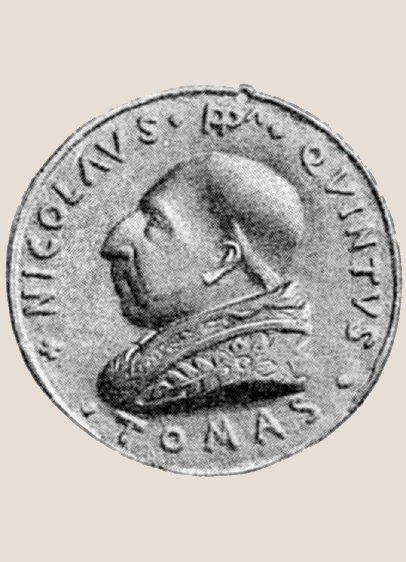Nicholas V
March 6, 1447 - March 24, 1455
BACKGROUND
Family and Birthplace
Pope Nicholas V's given name was Tommaso Parentucelli. He was born in Sarzana, Liguria, a small town on the west coast of Italy, roughly half-way between Genoa (south of Milan) and Florence.
Education and Church Offices
Tommaso studied theology at the University in Bologna.
He was made a cardinal by Eugene IV in 1446, and was elected pope the following year.
POLITICAL ACTS
Established the Concordat
Because he was an adept conciliator between the papacy and the German Church, Pope Nicholas was able to establish the Concordat of Vienna in 1448 with Frederick III, Emperor of the Holy Roman Empire. The Concordat restored the papacy's traditional powers in the Holy Roman Empire, including the right to collect annual taxes and to make church appointments.
Ended Schism
By persuading Felix V, the last of the competing claimants to the papacy, to abdicate in 1449, Nicholas erased the last vestige of the Great Schism.
Proclaimed Jubilee Year
In celebration of the restoration of unity to the Roman Catholic Church, Nicholas proclaimed 1450 to be a universal Jubilee year. This brought many foreign pilgrims to Rome and an influx of money, which Nicholas used to finance his rebuilding program for the city.
Attempted to Raise a Crusade
Nicholas was unsuccessful in his attempt to raise a crusade to recover Constantinople, the capital city of the Eastern Orthodox Church, which the Turks of the Ottoman Empire captured in 1453.
HUMANIST ACTIVITIES
Collected Manuscripts
Pope Nicholas, who is recognized as the first humanist pope, was an avid collector of Greek and Latin texts.
Donated his Manuscripts to the Church
Nicholas left his collection of about 1200 manuscripts to the Vatican, and this became the nucleus of the Vatican Library's collection. It remained for Pope Sixtus IV to formally establish a library.
Sponsored Greek Translations
Nicholas sponsored the translation of many Greek manuscripts. He employed translators such as Cardinal Bessarian, a Byzantine scholar who fled Constantinople and later settled in Venice. (Bessarian bequeathed his collection of Greek manuscripts to the Venetian Republic, and the Library of San Marco by Jacopo Sansovino was later built to house it.)
RESTORATION OF ROME
Campaign to Restore the City
Nicholas began a campaign to restore the city of Rome to its former grandeur. Many older parts of the city of Rome were crumbling from centuries of neglect. The project was not completed during Nicholas' lifetime, and except for the restoration of Rome's most important Early Christian churches, Nicholas' successor, Callistus III, halted work on his program of restoring the city.
Commissions
Nicholas began or commissioned plans for a number of projects.
♦City walls. Nicholas resumed the restoration of the city walls, which largely dated back to Roman times. The urgency of this project is underscored by its having already been begun by his predecessor, Eugene IV.
♦Bridges. Nicholas commissioned the repair and rebuilding of the city's bridges, including the Milvian bridge, which he fortified and strengthened.
♦Churches. He initiated the restoration of several older churches including Santa Maria Maggiore, San Lorenzo Outside the Walls, and St. Paul Outside the Walls.
♦Government palace. Nicholas remodeled the Palazzo dei Conservatori, one of Rome's administrative buildings, and added a loggia, which was removed when Michelangelo made a two-bay deep addition to the building's front a century later.
COMMISSIONS AT THE VATICAN
Return of Focus on the Vatican
Nicholas was the first pope to reside at the Vatican since before the Great Schism. He reportedly employed Leon Battista Alberti as an architectural adviser.
Commissions
Nicholas made additions and improvements to several parts of the Vatican. A contemporary biographer records that the pope had grand plans to expand the palace, but the extent to which it was carried out and the specifics of what was built remain unclear.
♦Nicholas V Wing of Vatican Palace. Pope Nicholas commissioned a wing, usually referred to as the Nicholas V wing, on the north side of the old palace. In the 16th century, this structure overlooked the tournament arena of the Belvedere Court, but today, it overlooks a parking lot.
♦Chapel Wing of Vatican Palace. Nicholas also added several rooms to the east of the Nicholas V wing that incorporated a medieval tower into the new fabric of the palace. In the encompassed tower, Nicholas built a small chapel dedicated to Saints Lawrence and Stephen. The lower portion of this wing contains a room that Pope Sixtus IV may have later used to house the Vatican Library. Nicholas employed the Florentine painter Fra Angelico and his assistant Benozzo Gozzoli, to decorate these rooms, and Fra Angelico also provided designs for an intarsia study. Only the chapel painted by Fra Angelico retains its original painting.
♦Tower of Nicholas V. Nicholas added a tower and two defensive walls on the northeast side of the Vatican palace.
♦Castel Sant'Angelo. Nicholas increased the defensive capability of the Castel Sant'Angelo by enlarging the original square base through the addition of circular bastions (later rebuilt as polygonal) to the corners. Plans to improve the Borgo, the area between the Castel and the Vatican, were not realized or preserved.




 Add Placemark
Add Placemark Go Back
Go Back 




